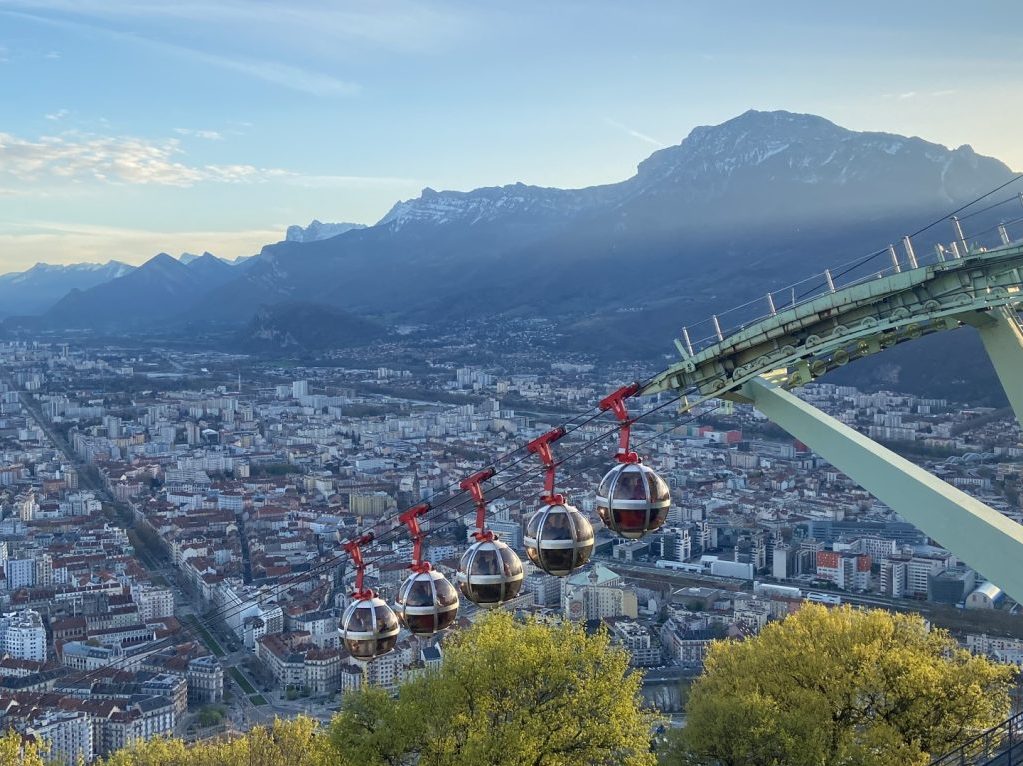Fort de la Bastille: Watching over Grenoble
There’s another Bastille, not the long-gone Revolutionary flashpoint, but the most iconic landmark of Grenoble: the mountainside Fort de la Bastille.
Grenoble, Capitale des Alpes, is curtained by three mountain ranges. Two, Belledonne and Vercors, are too vertiginous to be easily crossed. The third, Chartreuse, was once the exposed flank of Italy. So, just above where the Chartreuse touches the river Isère, where the city ends and the mountain begins, there is a fortress.
Hiking to the Bastille
On my first day in Grenoble, I crossed the Isère and mounted the magical stairs into the Chartreuse. The infrastructure of living and moving about on the hillside is well-built into the landscape, with hodgepodges of walled gardens and worn buildings, old stone and concrete steps leading off in tantalizing directions. But I stuck to my stairs, following them through scrubby forest onto the switchbacks to la Bastille, busy with hikers, trail runners, and families and dogs.
The view built itself from the ground up, white peaks faint above the haze, barely distinguishable from little puffs of white clouds; high rises and rooftops fanning out. The river began to show itself, teal and curving. Layers of fortifications multiplied on the hillside—layer after layer of stone towers and graffitied arches and gated-off tunnels.
Stairs disappeared into a dark tunnel angling directly through a wall. Perched on the end of one big wall was a little incongruous turret painted bright red. Where archways were ungated, my child-self wanted very much to see where they led, but my adult self was wary. I decided to be content with the fairy-tale shimmer of the unseen.
Finally, the switchbacks ended at the top layer of the fortress, where functional buildings perch on old walls: the keep-turned-restaurant, a museum, the disembarkation platform of the Téléphérique—round plexiglass cable cars from the 1970s nicknamed les Bulles, the Bubbles.
And one more staircase to the tip-top panorama terrace. Here, I began to hear snippets of English from tourists who took the Bubbles. French-adjacent flags from the regional to international fluttered over the view.
View from the Bastille
I was now standing at the most prominent point overlooking the fork of l’Y grenoblois, defined here by the southern tip of the Chartreuse massif. The smog, made opaque by the harsh afternoon light, hid the most impressive peaks of the Belledonne range, which outlines one arm of the Y. But the urban valley where I would be living, and the precipitous foothills that would become my daily backdrop, were all arrayed there for me.
Grenoble’s vieille ville was the red-roofed, star-rayed center tucked amid the pale, blocky concrete sprawl, hugged along its edge by the blue coil of the Isère. The river wraps around the foot of the mountain, swinging from one arm of the Y to the other.
On the other side of the terrace, I could see the river making its way between the Chartreuse and Vercors massifs (both part of the Pre-Alps, craggy but less dominating than their true Alpine big sister Belledonne). There, the Isère is joined by the Drac, the river carving out the stem of the Y between Belledone and Vercors.
… And above it all, the five plexiglass Bubbles pause precipitously after each cycle of the cable.

History of the Bastille
Informational signs on the terrace tell the story, in both French and English, of the Fort de la Bastille.
The strategic vulnerability of the Chartreuse has fluctuated over the centuries as lines were drawn and re-drawn. The version of the fort I stood on was completed by one ambitious Lieutenant-General Haxo in 1847 after new treaties (au revoir, Napoleon) had exposed Grenoble to the alpine frontier of the Duchy of Savoy.
Before the 19th-century fort, there were 17th-century walls built by Huguenots after taking Grenoble from the Catholics, but they fell into disrepair and most vestiges were cleared by Haxo.
But not a single cannon was fired from his shiny new fort because Savoy was subsumed into France only 13 years later. The increasing deadliness of artillery soon rendered the walls obsolete anyway.
The way back down
I wandered back down the stairs and behind the fort’s defenses. My walk was graced by scrubby trees that had yet to break bud, wild folds of rock, stone ruins perched on cliffs, bronzing evening light over open grass, rusted implements of defunct cable cars, dark caves drilled into the mountainside by Haxo.
On my return, instead of the switchbacks, I found Haxo’s giant stairs—l’escalier des géants, a steep and blocky vision of concrete geometry straight down the mountainside. I jolted down all 400 of them. I left the fort via the archway of Porte Saint-Laurent on the riverbank, one of the last remaining towers built by the Huguenots.
Evening visit
The smoggy view I got on that first visit was redeemed by my second visit, a jaunt via car up intensely steep switchbacks of residential backstreets. It was evening and we went up to the terrace for the crystalline light slanting over the valley.
This time, Belledonne was sparkling clean in the sky and distant peaks stood out in the remaining reach of the sun.
The city also caught the light, turning high-definition. I could see the long, straight Avenue de Jean Perrot and even the fountain in the city-center Place de Verdun. Vercors was deepening blue.
After sunset, Belledonne lingered pink with alpenglow and the Isère turned satin.
Perhaps it’s a shame that so much work went into building a fortress that wasn’t necessary. But although it’s not keeping anyone out, la Bastille is serving a purpose Haxo could have never foreseen: delighting the people who live in and visit Grenoble.
Not to mention keeping les Bulles in business.
Have you ever been to Fort La Bastille, Grenoble?










